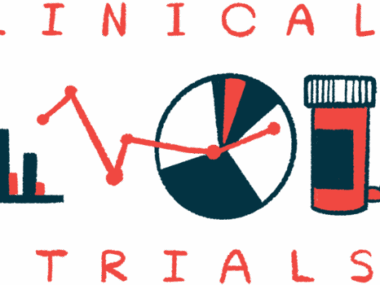LAM561 as add-on may delay glioblastoma disease progression
Use of therapy shows benefits in certain patients in pivotal trial: Interim data
Written by |

Adding the investigational therapy LAM561 to standard of care treatment may delay disease progression or death in people with newly diagnosed glioblastoma whose tumors exhibit a marker called MGMT methylation, according to interim trial analyses.
However, while the findings demonstrate promise for LAM561 in treating this aggressive brain cancer, final conclusions can’t be drawn until overall survival analyses have been conducted, with those data expected by the end of 2026, according to the therapy’s developer Laminar Pharma.
The trial is considered a pivotal study, meaning that if the findings should be positive, they could support regulatory applications seeking approval of LAM561.
“We are encouraged by the progression-free survival results from this trial in MGMT-methylated patients, which, if reflected by positive overall survival results, may represent a significant advance in the treatment of glioblastoma,” Pablo Escribà, PhD, CEO of Laminar, said in a company press release. Escribà noted that the condition, which affects more than 100,000 people each year, does not have a good prognosis.
Investigating LAM561 as treatment for patients with aggressive brain cancer
Glioblastomas are an aggressive form of glioma, a class of brain tumors that form in support cells of the brain or spinal cord. The prognosis is generally poor, and treatment options are limited. Standard of care, or SoC for short, involves surgery to remove as much of the tumor as possible, followed by chemoradiation, which is radiation therapy plus chemotherapy.
About 30%-50% of glioblastoma patients’ tumor cells exhibit a chemical modification called methylation that silences the MGMT gene, which normally encodes the production of a DNA repair enzyme. This makes tumor cells more vulnerable to the DNA-damaging effects of chemotherapies. As such, MGMT methylation is associated with improved treatment responses and better outcomes.
LAM561, also known as 2-hydroxyoleic acid (2-OHOA) or idroxioleic acid, is a lab-made derivative of oleic acid, a naturally occurring fatty acid. It’s designed to alter the composition of cancer cell membranes, reducing the activity of signaling proteins that promote tumor growth.
Early preclinical and clinical data have demonstrated that LAM561 can effectively target and modify molecular pathways linked to glioblastoma growth, according to Laminar.
The Phase 2/3 CLINGLIO trial (NCT04250922) enrolled 144 adults, ages 18-75, with newly diagnosed glioblastoma without IDH mutations, a genetic change seen in some gliomas. The participants were randomly assigned to receive SoC chemoradiation — which included the oral chemotherapy temozolomide — with or without the addition of oral LAM561 after surgery.
One of the study’s main goals is to evaluate LAM561’s effects on progression-free survival (PFS), or the time alive without cancer progression, after 66 PFS events — incidents of disease progression or death — had occurred in the trial. The other main goal is to look at the therapy’s effects on overall survival, assessed after at least 90 deaths have happened.
In November, an independent data monitoring committee met to review interim study data after the 66 specified PFS events had occurred.
Study unblinded to allow analysis of therapy’s effect on disease progression
The analysis showed that although LAM561 was well tolerated, it did not significantly prolong PFS relative to standard care across the entire study population.
Still, the committee recommended that the study did not need to be stopped for safety or futility — meaning lack of efficacy — reasons, and should proceed as planned until the overall survival endpoint is assessed.
CLINGLIO was initially being conducted as a double-blind study, meaning that investigators, participants, and Laminar did not know who was getting the experimental therapy and who wasn’t. That protocol is intended to prevent bias that could influence study results. In their recommendations, the committee urged that the study be unblinded, to allow Laminar to see which patients received LAM561 and to perform ongoing analyses — though such analyses can’t be statistically analyzed.
Now, analyses of data available as of Feb. 18 show that LAM561 may have a PFS benefit in the subset of patients with MGMT methylation.
In MGMT-methylated patients with a Radiation Therapy Oncology Group (RTOG) score of 4, the median PFS with LAM561 was 86.4 weeks, or longer than 1.5 years. That compared with 54.7 weeks, or slightly longer than a year, in the SoC arm, amounting to a 47% lower risk of disease progression or death with LAM561.
RTOG is a way of assessing the severity of side effects from radiation therapy, with scores ranging from zero, for no toxicity, to five, for side effects related to death.
Glioblastoma remains one of the most challenging cancers to treat, and these findings highlight the potential of LAM561 to improve outcomes for methylated patients, a considerable portion of the total glioblastoma population.
A similar trend was observed in methylated patients with RTOG scores of three, where the median PFS with LAM561 was 56.7 weeks, or slightly longer than a year, compared with 19 weeks, or approximately five months in patients on SoC. PFS was not improved in the subgroup of unmethylated patients.
“Glioblastoma remains one of the most challenging cancers to treat, and these findings highlight the potential of LAM561 to improve outcomes for methylated patients, a considerable portion of the total glioblastoma population,” Escribà said.
An ongoing Phase 1/2 clinical trial (NCT04299191) is testing LAM561 in pediatric patients with aggressive gliomas or other solid tumors that haven’t responded well enough to treatment or for which no standard treatments are available. That study is recruiting up to 28 children at two sites in Arkansas and New Jersey.








